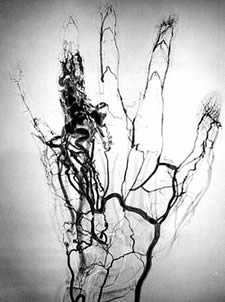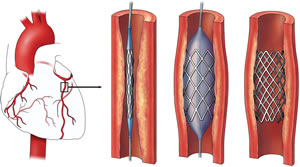Difference between Angioplasty and Angiography
Key Difference: Angiography is the process of taking an x-ray of the blood vessels to see which vessel is obstructed and requires repairing. Angioplasty is the method of widening the narrowed or constricted arteries or blood vessels.
 The terms angioplasty and angiography are medical terms that refer to a procedure related to blood vessels. These medical terms are often confused and used interchangeably by people that are not of the medical field as they seem similar in nature. Although, these terms are both related to blood vessels and are related, the terms refer to two different procedures. One must understand that the term is not specific to any particular organ or anatomically specific. A procedure performed on the vessels in the heart is known as Coronary Angioplasty and Coronary Angiography. Let’s try and understand the differences between the two processes.
The terms angioplasty and angiography are medical terms that refer to a procedure related to blood vessels. These medical terms are often confused and used interchangeably by people that are not of the medical field as they seem similar in nature. Although, these terms are both related to blood vessels and are related, the terms refer to two different procedures. One must understand that the term is not specific to any particular organ or anatomically specific. A procedure performed on the vessels in the heart is known as Coronary Angioplasty and Coronary Angiography. Let’s try and understand the differences between the two processes.
Breaking down and translating the words gives us a clearer picture of the two different processes. Angio in both the words is derived from the Greek word ‘angion’ and can be translated as “vessels or cavity”. Now, the word ‘plasty’ is derived from Greek word ‘plasso’ and translates into “form or mould”, while the word ‘graphy’ is derived from Greek word ‘graphein’, meaning to “to write or record”. So, with these definitions it is safe to assume that angiography means to record or picture the blood vessels, while angioplasty means to form, mold or repair the blood vessels. In order to perform of an angioplasty, a medical professional must first conduct an angiography of the vessels.
Angiography is the process of taking an x-ray of the blood vessels to see which vessel is obstructed and requires repairing. There are multiple reasons as to why a blood vessel becomes constricted or blocked. The most common is the blockage that happens in the coronary arteries. Prior to opening up the heart to see the problem, angiography is used to visually place the problem and understand what must be done about the problem. Angiography is also known as arteriography, arteriogram and venogram. Angiography is performed with guide wires, catheters, CT/X-ray machine and a special type of die.
The process requires inserting catheters into the vessels by the groin or arm and special dye is released into the blood vessels. This special dye or contrast agent absorbs the x-rays and shows up prominently on the X-ray. The X-ray of the blood vessels or arteries allows the medical professional to see where the blood flow is restricted and how many blockages are present. This gives an accurate picture of where the angioplasty must be performed.
 Angioplasty is a procedure that is performed following angiography. Once the doctor has the idea where the blockage is present, he will try and relive the blockage using Angioplasty. Angioplasty is the method of widening the narrowed or constricted arteries or blood vessels. The most common procedure is done by a balloon and is known as balloon angioplasty. If the person suffers from multiple clots or requires a much complicated procedure, then the doctor would rather perform an open by-pass surgery to reduce complications.
Angioplasty is a procedure that is performed following angiography. Once the doctor has the idea where the blockage is present, he will try and relive the blockage using Angioplasty. Angioplasty is the method of widening the narrowed or constricted arteries or blood vessels. The most common procedure is done by a balloon and is known as balloon angioplasty. If the person suffers from multiple clots or requires a much complicated procedure, then the doctor would rather perform an open by-pass surgery to reduce complications.
Balloon angioplasty is performed by inserting an empty and collapsed balloon on a guide wire, known as balloon catheter. The catheter is passed through the blockage, with the collapsed balloon being placed where the blockage is present. The balloon is then inflated using water pressure that is higher than the blood pressure. As the balloon fills up with water, it pushes the blockage upward into the surrounding muscular wall, opening up the blood vessel for an improved flow. The balloon is then deflated and then withdrawn. The doctor may also place a stent that ensures the vessel or artery remains open.
Angioplasty and angiography is not only limited to a special organ and can also be performed in various different parts of the body. There are multiple types of angiography including: Coronary angiography, Microangiography, Neuro-vascular angiography and Peripheral angiography. Coronary angiography is performed in arteries or blood vessels in the heart. Microangiography is used to visualize tiny blood vessels. Neuro-vascular angiography is performed to visualize the arterial and venous supply to the brain, incase of a stroke or reduced blood flow to the brain. Peripheral angiography is performed to detect vessel narrowing in patients with leg cramps or leg claudication.
Various types of angioplasty includes: Peripheral angioplasty, Coronary angioplasty, Renal artery angioplasty, Carotid angioplasty and Cerebral arteries angioplasty. Peripheral angioplasty refers to the angioplasty that is performed using a balloon catheter to widen vessels outside the coronary arteries. Coronary angioplasty is performed on the coronary vessels of the heart. Renal artery angioplasty is used to treat narrowing of blood vessels in the renal area which includes abdominal area. Carotid angioplasty is used to help widen the carotid artery caused by Carotid artery stenosis. Cerebral arteries angioplasty is used to widen the blood vessels in the brain.
Image Courtesy: en.wikipedia.org, timelymedical.ca









Comments
sayed
Sat, 03/17/2018 - 11:01
Siddharth tiwari
Thu, 07/27/2017 - 12:19
Devansh Tripathi
Mon, 06/12/2017 - 19:28
Shahid
Mon, 07/03/2017 - 09:29
Dr. Khalid Awan
Mon, 06/12/2017 - 16:33
Tyagi
Mon, 08/08/2016 - 16:31
Tyagi
Mon, 08/08/2016 - 16:31
Kushal Dutta
Thu, 06/23/2016 - 23:58
Rabindra Choudhury
Mon, 05/23/2016 - 23:14
Vipra Vilas Mal...
Wed, 01/27/2016 - 18:42
Pages
Add new comment